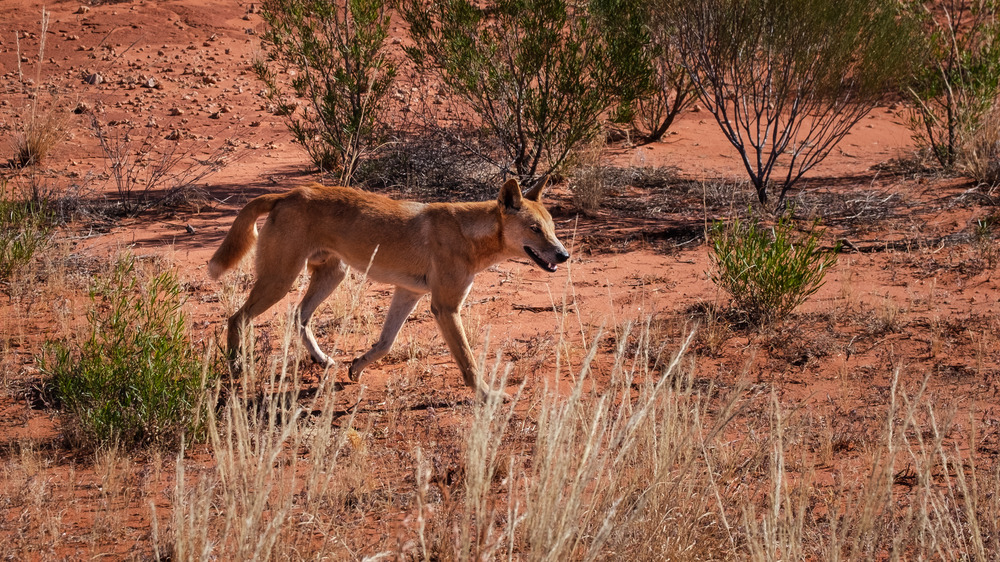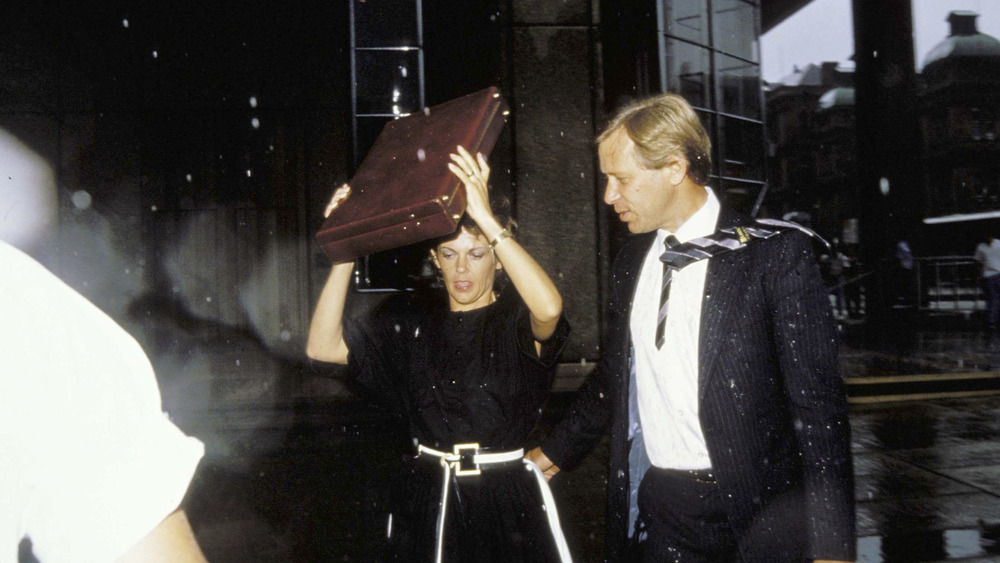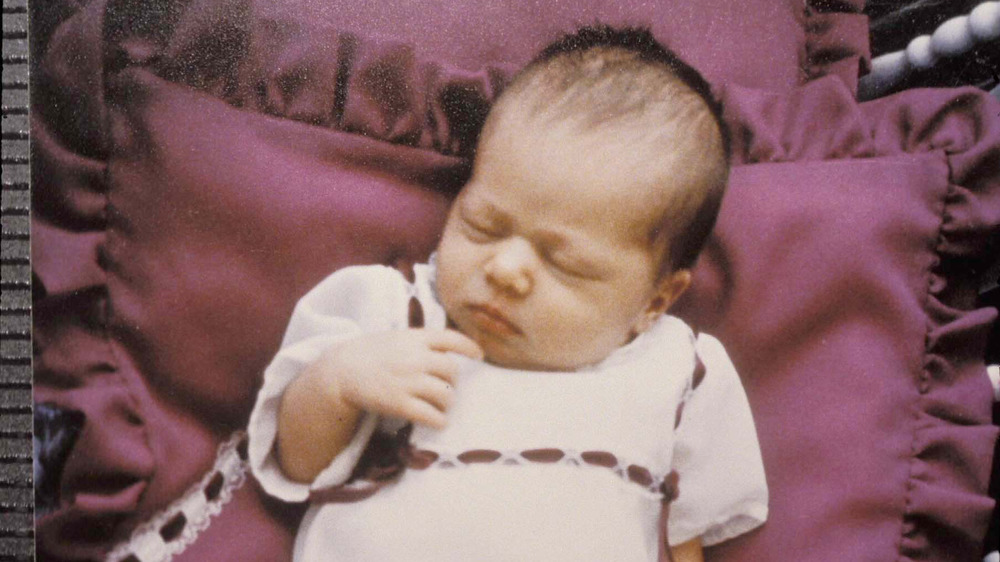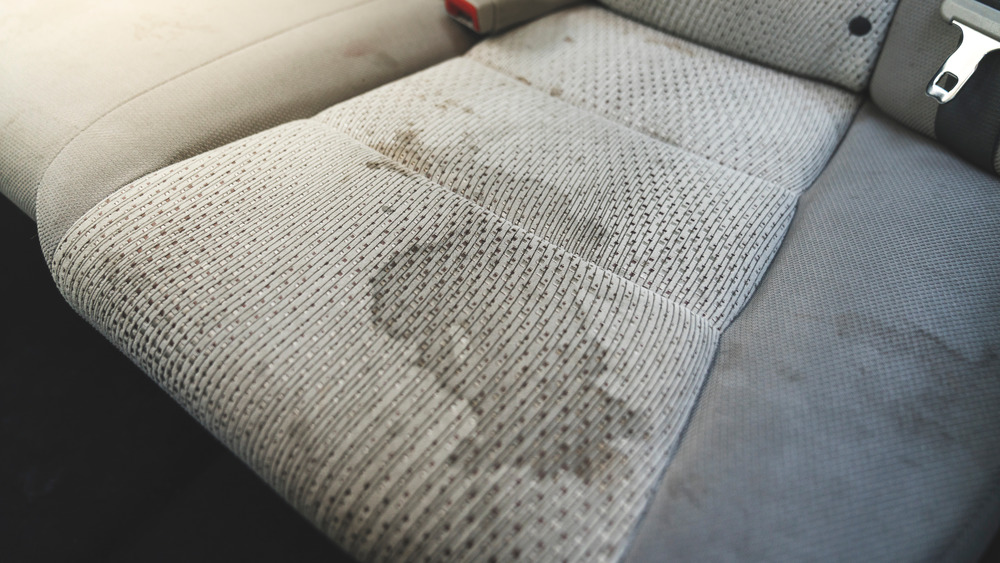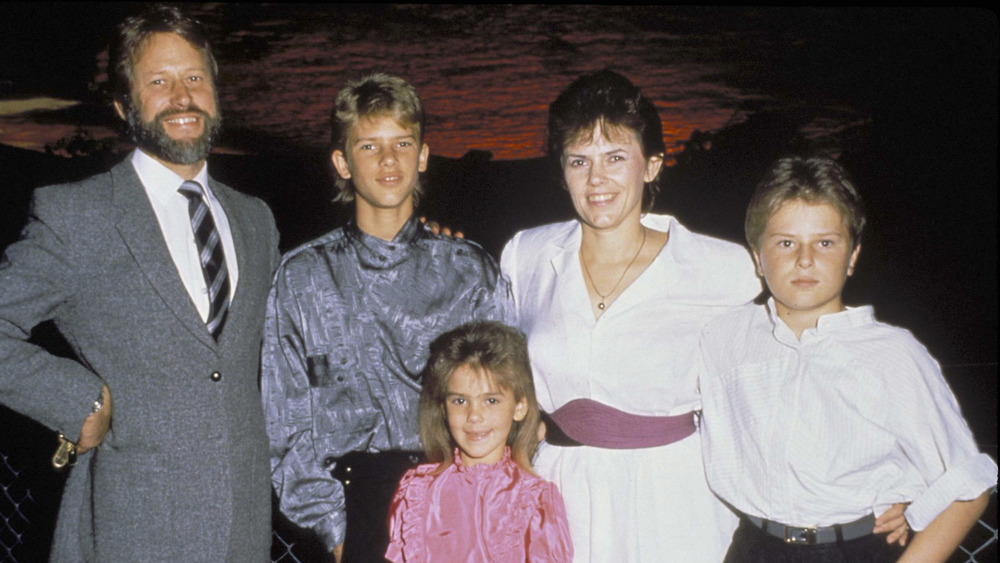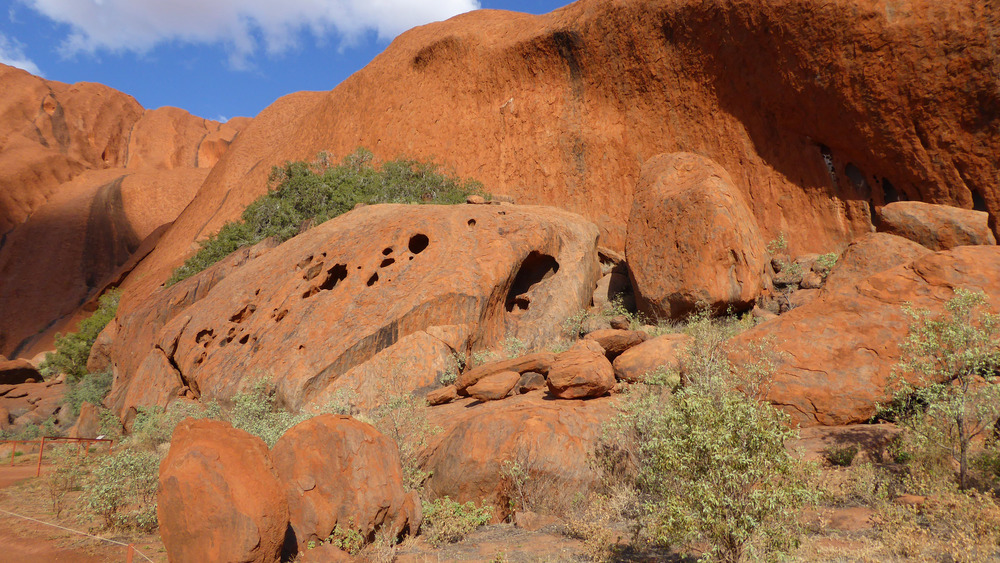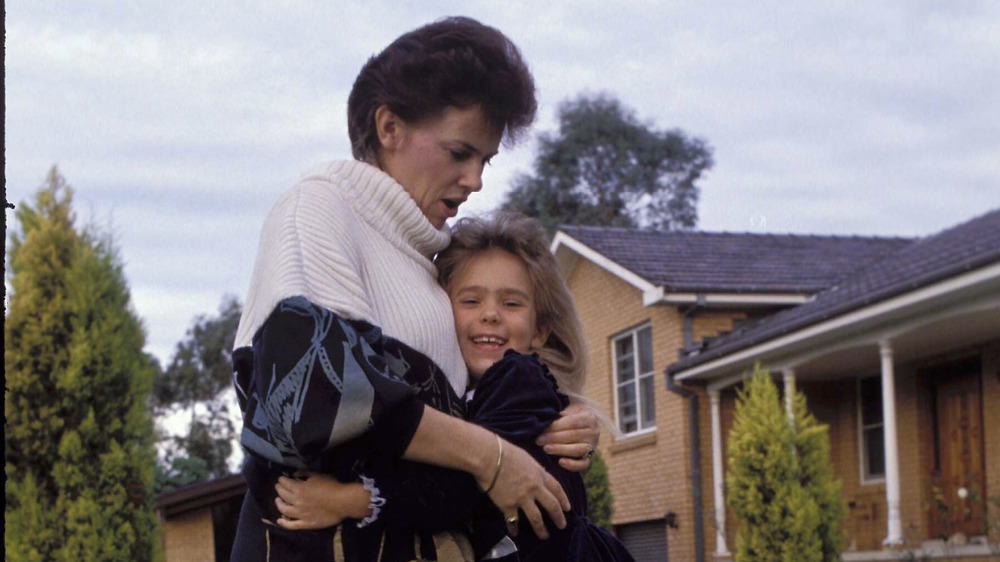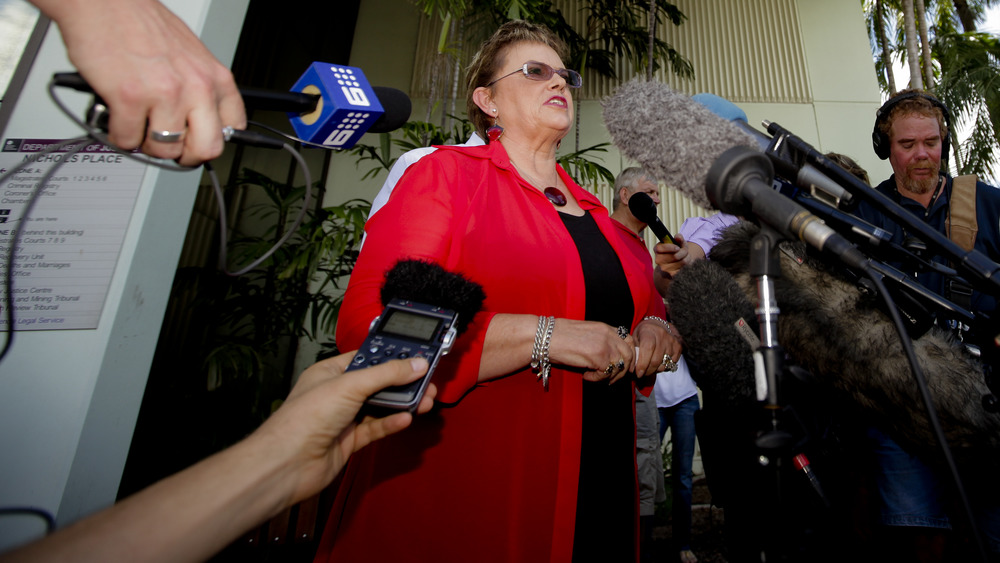The Messed Up True Story Of "A Dingo Got My Baby"
If there's one thing pop culture has taught us, it's that Australians are exceptionally concerned about dingoes eating their babies. It must happen all the time, considering the enormous number of references you can find in various television shows and movies to dingoes eating or stealing children. What even are dingoes, anyway? It doesn't matter, they just have a funny name! (They're similar to feral dogs, for the record.)
The truth is, all of those jokes are based on a real event, and the story behind it is pretty horrifying if you're a parent or even just someone who cares about how the media and legal system influence one another. So while American television writers were yukking it up, an actual, horrible tragedy played out in Australia in the 1980s.
Fair warning — After you hear the terrible origin behind the famous phrase, you might look at some of your comedy faves a bit differently.
One night in Uluru
Michael and Lindy Chamberlain were a happily married couple with three children — Aidan, Reagan, and their youngest, little baby Azaria, just over two months old. The Chamberlains were also very outdoorsy, enjoying hiking, camping, and even some rock climbing. While there were many places in their home country of Australia good for these activities, one of the most impressive was a place in the Northern Territory called Uluru (then referred to as Ayers Rock).
And so, on Aug. 17, 1980, the Chamberlain family took a little trip up north with their newborn daughter, according to Famous Trials. Everything was going well, and photos taken from the trip show a happy, normal family. They even met up with several nearby other campers and had become friendly with them, to boot. Things were about to change drastically, however.
While sitting around the campfire with their fellow campers that night, Lindy excused herself and walked away. Sometime between five to ten minutes later, she returned briefly, but left again when she heard Azaria Chamberlain cry. Moments later, her husband Michael and the other campers heard her shouting. According to Lindy, she had gone into the family's tent to check on Azaria but found her gone, blood inside the tent, and a wild dingo running away, according to The 13th Floor. Hours later, an extensive search of the area began, but Azaria was nowhere to be found.
Suspicions begin to arise
Following the search, the case briefly came up in news reports across Australia, merely because it was so unusual. But before long, people continued talking about it, and some folks, especially those in the media, began asking a lot of questions about the Chamberlains and the story.
At the time, dingoes were normally considered fairly docile creatures, only eating small animals and typically too frightened of humans to even approach them, according to The New York Times. This alone began to raise a few suspicions that perhaps Lindy Chamberlain's story was not as it seemed. After all, if dingoes ate babies, wouldn't it happen all the time? Then there was a question of whether or not a dingo could even carry a baby, especially for any sort of long distance.
The initial inquest into the case by authorities saw no reason to doubt the stories of the Chamberlains and their fellow campers, according to Famous Trials. They agreed that Azaria Chamberlain had been taken by a dingo and was presumably dead. But by this time, public discourse about the case had grown out of control, and even Australia's legal system had been swayed by people casting doubt on the events in question. The Supreme Court overturned the results of the first inquest and ordered a second one to be conducted that would inevitably cast a more skeptical eye on the Chamberlains and their version of events.
The demonization of the Chamberlains
In addition to standard questions about the oddness of the case, many nasty rumors and speculation began to crop up about the Chamberlains themselves, much of which the media reported on completely uncritically. Specifically, there were two things that made the public highly suspicious of the family claiming a dingo stole their child.
First was the demeanor of Lindy Chamberlain herself. The public saw her as cold and distant, not anguished and mournful like they'd expect a grieving mother to appear, according to The 13th Floor. In numerous interviews, Lindy was calm and detailed in her descriptions of what happened, what the tent looked like when she got there, and the chances of them ever finding Azaria Chamberlain alive. She didn't cry or wail, instead choosing to methodically talk about the details of the case.
Secondly, there was the Chamberlains' religion. Michael and Lindy were Seventh Day Adventists, a Christian denomination almost unheard of in Australia at the time. They had actually met through their faith and were both very devout. But in the 1980s, there was a lot of misinformation about the group, and they were the subject of some particularly disturbing rumors, according to Famous Trials. Some even claimed that they were not Christian at all but actually devil worshippers who sacrificed children. Thus the Chamberlains must have killed their own child as part of their religion. Much was also made of the fact that Lindy occasionally dressed Azaria in black dresses.
Another inquest, with highly different results
Due to public scrutiny, Australia's legal system was under a lot of pressure in the Chamberlain case. While the first inquest focused primarily on other campers who were there that night and their testimony, the second was based heavily on physical evidence. Namely, Azaria Chamberlain's jumpsuit, the only piece of her clothing that investigators could find. (Keep in mind that her jacket hadn't been found.) It had been located a few miles from the tent and was covered in blood.
According to the inquest and, later, the prosecution in the Chamberlains' court case, experts had examined the jumpsuit and found a particular cut near the neck to appear too straight to have been made by an animal, positing that this cut was made by scissors, according to Famous Trials. Furthermore, ultraviolet photos seemed to reveal something damning on the back of the jumpsuit. A hand-shaped mark, invisible to the naked eye, seemed to have been created when someone with bloody hands touched the child.
This was enough to satisfy the investigators and lawyers. Lindy Chamberlain was charged with first-degree murder and Michael Chamberlain with accessory to murder of their daughter, Azaria Chamberlain. This was only the beginning of a long legal quagmire that the Australian courts and Chamberlain family would soon find themselves in.
Blood evidence
When the Chamberlains' trials began, the prosecution laid out their second piece of evidence, which they found far more damning than the jumpsuit. According to their experts who tested stains found in the front seat of the Chamberlains' car, it seemed very probable that there was no dingo attack at all.
The stains came back as containing a compound known as fetal hemoglobin, according to Famous Trials. It's exactly what it sounds like — blood from a very small child. In fact, fetal hemoglobin is only found in children under six months of age. Azaria Chamberlain was just over two months old when she disappeared. If there were bloodstains of this type in the front seat of the Chamberlain family vehicle, it indicated that Azaria was actually killed in the car, not by a dingo.
This, combined with the jumpsuit that appeared to have cuts from a cutting implement led investigators to surmise that Azaria had been taken from the Chamberlains' tent to their car, and it was there that she was murdered, possibly from a slit throat. Under these circumstances, the killer could only be Lindy Chamberlain, who had stepped away from the fire. Michael Chamberlain either knew about the whole thing or had seen or heard something suspicious, so he was charged, presumably in hopes that he'd give up anything he had on his wife.
A tale of two mothers
There was a big problem with the prosecution's case — They had been unable to find any kind of motive for Lindy or Michael Chamberlain to want to kill Azaria Chamberlain, according to Famous Trials. Numerous friends, family, and community members were more than happy to say good things about the Chamberlains, especially about Lindy's parenting skills. She had no history of mental illness, and there were no signs of any sort of domestic abuse in the Chamberlain household. No strange bruises or injuries, no police visits. It's like the prosecution was talking about an entirely different woman.
Furthermore, the defense was able to show that dingoes had been spotted in and around Uluru on the night of Azaria's disappearance. Contrary to popular belief, dingoes can and had been violent toward humans, including children, in the past, according to Mental Floss. They even had a dingo expert testify that a dingo absolutely could make the clean cut that the prosecution said could only come from a blade.
As for the fetal hemoglobin, while it's true that it's only found in children under six months of age, the defense demonstrated that the test was unreliable. They found that adult blood and even a chocolate milkshake could give a false positive, according to ABC (Australia) News. The Chamberlains' lawyers argued that the prosecution's case was based purely on circumstantial evidence, and even that was extremely flimsy.
The chain of events
While it seemed like the Chamberlains' defense lawyers had poked all kinds of holes in the government's case, the jury disagreed. They still believed Lindy Chamberlain was too calm and rational to be a grieving mother. Lindy was sentenced to life in prison and Michael Chamberlain to 18 months for the murder of their infant daughter, according to Famous Trials.
Thus, the prosecution's version of events became the accepted one. In it, Lindy left the campfire that evening and returned to the family's tent. From there, she took Azaria Chamberlain straight to the car. She cut the baby's throat with a pair of sharp scissors police had found in the car, hid her body in a large camera case, cleaned everything up, and spread blood around the tent to make her story more believable.
She also did all of this without raising any suspicions among the other campers and, most surprising of all, was able to do so in the span of only five to ten minutes, the length of time eyewitnesses said she was gone from the fire before she shouted that a dingo had her baby. Needless to say, if these events happened the way the prosecution said they did, Lindy would be an extraordinarily fast and resourceful killer.
A twist no one saw coming
The Chamberlains were imprisoned in 1982. Michael Chamberlain served his far shorter sentence, and the two even had a fourth child shortly after Lindy Chamberlain was sentenced, further confusing the government's narrative that Lindy had mysteriously and stealthily murdered their third child, despite never harming the other children or even showing any signs of mental distress.
In fact, for nearly four years, Lindy simply served her sentence, according to Famous Trials. Then, in early 1986, something very unexpected occurred, purely by happenstance and because of another tragedy. A British tourist, David Brett, was rock climbing in Uluru when he lost his footing and fell to his untimely death. It took authorities several days to locate his remains, and when they did, they found Brett in an area with multiple dingo lairs.
As part of a routine practice, perhaps in hopes of closing some old cases still on the books, police searched these lairs for bones or other evidence. That's when they found something that turned the entire case on its head, according to The 13th Floor. Outside one of the lairs, searchers located the jacket Lindy described Azaria Chamberlain wearing the night of her death — the one that had never been found — stained with blood.
The taste of freedom
The discovery of this new evidence led the courts to immediately reopen the Chamberlain case. Michael Chamberlain had already served his sentence, but Lindy Chamberlain was still sitting in prison for life. Not for much longer, however. In February of 1986, a month after Azaria Chamberlain's jacket was found, Lindy was ordered released from prison, according to Famous Trials. It wasn't until 1988, though, that the two were finally cleared of the crime of murdering their two-month-old daughter.
A reexamination of the evidence in the case led investigators to take the defense's claims from the trial more seriously. Their fetal hemoglobin test was flawed, and upon further research, they found out that the mystery "bloodstain" in the Chamberlain's car was actually overspray from a chemical used in the car's manufacturing process meant to be used as a sound dampener to make the interior of the vehicle quieter.
Still, questions remained, and there was no shortage of people who still didn't trust the Chamberlains. The jacket wasn't a (non) smoking gun that proved their innocence, according to some continuing rumors. All it proved was that a dingo had picked up the bloody jacket at some point and taken it back to its lair. It's possible, the rumors said, that Lindy simply discarded the jacket after killing Azaria.
A slow march toward innocence
In 1990, four years after Lindy Chamberlain was released from prison, the family was still battling in court. This time, it was compensation from the Australian government for their false imprisonment, for which they were awarded $1.3 million, according to Famous Trials.
However, the Chamberlains still had the stain of the ordeal to manage, and as far as the government went, the results of the second inquest remained on the books as murder. The Chamberlains were seemingly willing to ignore this and try to start over again, but the second inquest into their daughter's death would come back to haunt them once more.
In 1995, a third inquest was ordered in the case due to a technicality. While the Chamberlains had been imprisoned and later released, it turned out that the second inquest was never finalized, seemingly slipping through the cracks after the Chamberlains were sentenced and exonerated. In the intervening years, the Australian government had enacted a policy of redoing any unfinished inquest. While this wouldn't have been a big deal, the investigator in the case concluded that Azaria Chamberlain's death was "open," meaning that Azaria's cause of death was still unknown, further deepening the Chamberlain family's old wounds. In the eyes of the government investigators, while the Chamberlains were cleared, there still wasn't proof that a dingo had taken the child, according to Mental Floss.
Two steps forward, one step back
Even after all they'd been through, the Chamberlains were furious that the government still didn't seem to believe them. They remained the butt of many jokes in not just Australia but all over the world. After the results of the 1995 third inquest, Lindy and Michael Chamberlain (who had actually divorced in the years since their trials) grew angry and demanded a fourth and, hopefully, final inquest.
For nearly a decade, it seemed their voices were unheard by the Australian legal system. But in 2010, amazingly, the government finally agreed to perform a fourth inquest, according to The Guardian. This investigation, performed by coroner Elizabeth Morris, finally put an end to decades of false accusations and suspicion when its results were revealed in 2012. Azaria Chamberlain was found to have been killed in a dingo attack, just like the first inquest had found over 30 years before, according to the New York Times.
Lindy and Michael were finally completely innocent in the eyes of the law. As a result of the inquest, Azaria's death certificate was updated and reissued to reflect that her cause of death was by dingo attack, not murder, and the government harbored no further suspicions otherwise. While things had cleared up in the Australian legal system, Lindy and Michael still had, and continue to have, a long way to go on making the public finally come to terms with their innocence.
The cultural persecution of the Chamberlains
And now back to endless jokes about dingoes eating babies in pop culture all over the world. Many people in the United States didn't, and still don't, know that this was a reference to real and awful events. Seinfeld, The Simpsons, and numerous others used "a dingo ate my baby" just like a kid saying their dog ate their homework. Even people who weren't alive when Azaria Chamberlain disappeared (which might be a good chunk of the people reading this) probably heard it.
In 1988, Meryl Streep starred in A Cry in the Dark, where she played Lindy Chamberlain and immortalized claims of baby-eating dingoes forever, according to the New York Times. Pop culture in the U.S. turned it into a gag and never really went past that point, nor were most of us aware that the child's parents were eventually vindicated and found innocent by pure luck. It hasn't really gone away, either. Even today, people continue to laugh about baby-snatching dingoes. Just about every amateur comedian who puts on a corny faux Australian accent usually brings it up basically right away.
Michael Chamberlain passed away in 2017, but Lindy Chamberlain is still alive and continues to have to live with people making tasteless jokes about a tragedy, with even more horrors to follow, that befell her family over 40 years ago.
